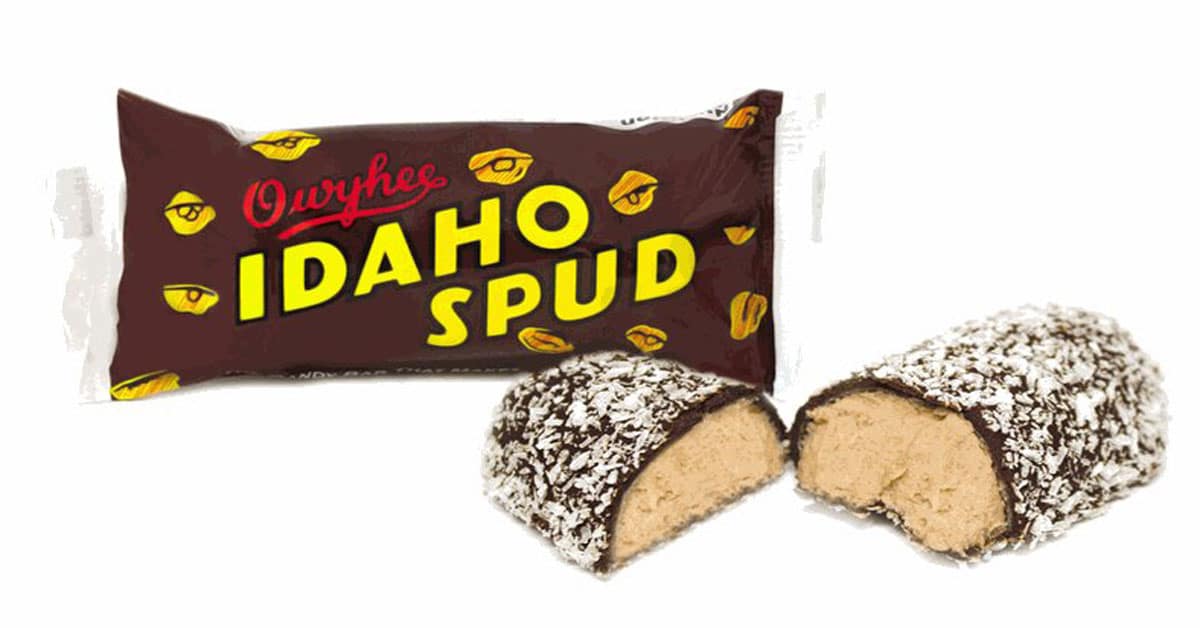Idaho Spud – The Candy Bar That Makes Idaho Famous
Potato cultivation and harvesting are well-known in Idaho, and this love for potatoes is also shown in the candy products too. The Idaho Spud Candy Bar resembles a long, thick potato in shape, but its flavor is unlike any other marshmallow-based confection you have ever encountered. The crunchy and earthy flavors of the chocolate and coconut coverings contrast with the sweet and uniquely flavorful cocoa of the thick interior marshmallow.
In this article, we will introduce and explore the delicious and mouthwatering Idaho Spud.
Please leave a review or any memories of this snack in the comments at the bottom of this page. Thank you!
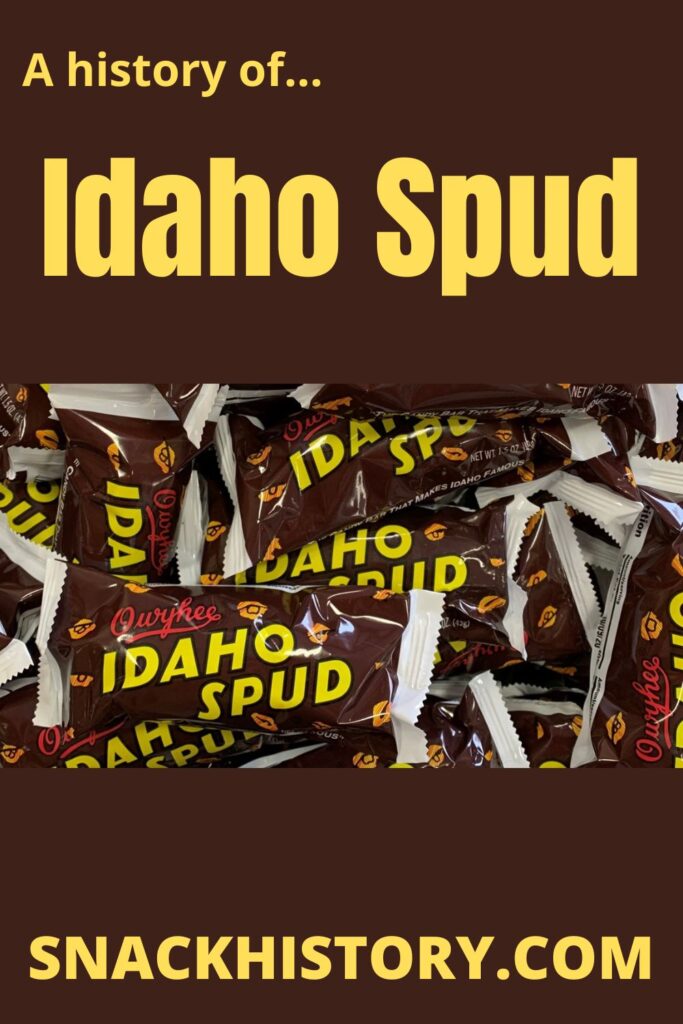
Overview
One of the oldest candy bars currently in existence, the Idaho Spud Candy Bar, first appeared in 1918. Thomas “T.O.” Smith, the company’s creator, is the man behind this chewy, soft Idaho Spud candy bar.
The Idaho Spud is among the top 100 candy bars in the Northwest of the United States, according to the Idaho Candy Company. Though offered at room temperature, the bar is frequently frozen before being eaten. Additionally, they are offered in transparent plastic tubs as bite-sized sweets.
According to Dave Wagers, in 2021, the business would sell around 2 million Idaho Spuds. The majority, or perhaps 60% of the bars sold, are sold in Idaho, with the remainder being sold in the states bordering Idaho. Of course, it seems natural that the Idaho Spud is a favorite in the location where it gets its name.
The brand still uses very similar packaging as it did in the 30s and 40s. If you look closely, you can see little potato eyes on the brown wrapper that reads “Idaho Spud” in yellow.
Origin of the Name
To be clear, an “Idaho Spud” does not include any potatoes. Naturally, Idaho is known for its potatoes, and according to the Idaho Potato Commission, missionary Henry Spaulding planted the state’s first potatoes in 1837. By the 1870s, growers in the Idaho Territory were sending potatoes throughout the western United States, and by the 1890s, Idaho was well-known throughout the country for its prized potatoes.
With more than 13 million pounds of potatoes produced in the most recent years for which data is available, Idaho led the country. Washington, which formerly contained the entirety of what is now Idaho inside its boundaries, came in second with almost 10 million pounds. Interestingly, the most popular variety grown in Idaho is the Russet Burbank, developed, at least in part, by Luther Burbank, the same 19th-century horticulturist blamed/credited for the Himalayan Blackberry.
The Idaho Candy Company produced the Idaho Spud Candy Bar to promote the state on a national scale. Even though an Idaho Spud doesn’t include any potatoes, the bar’s appearance and packaging are inspired by tubers.
Additionally, a “spud” is a type of antique shovel that was once used to dig up something resembling a potato.
Idaho Candy Company
T.O. Smith founded the Idaho Candy Company in 1901 to help support himself and his expenses after assisting with the construction of the Dewey Palace Hotel in Nampa.
He once used shoe boxes to deliver sweets from door to door. His company soon expanded, enabling him to hire seventeen candy makers to assist him in producing sweets for Idaho’s residents of all sweet tooth types.
To accommodate the expanding demands of his clients, Mr. Smith collaborated with the Adams family in 1909 to construct a cutting-edge plant at 412 South 8th Street in Boise.
The new plant, built in 1909, was hailed as Boise’s most cutting-edge structure at the time. Skylights and an employee “wellness” area were installed in the plant. Even some of the machinery from the early 1900s is still employed in their 23,000-square-foot facility where they create sweets.
The Idaho Candy Company faced difficult times in the 1930s and 1940s. The national confectionery titans began to grow after the Great Depression. Adams succeeded Smith as company president after Smith withdrew from active engagement in the firm at the age of 50 due to becoming blind.
Up until his passing in 1954, Smith had a stake in the company. Adams handed the business on to his children, who in turn sold it to Don Wakeman, the son of a veteran factory superintendent, in 1966. Wakeman started working for the organization in 1937, stacking shelves. Before going back to buy Idaho Candy with his partner, Nif Sullivan, he later worked at Gillette.
Even after a failed attempt to make the Idaho Spud a national brand in the 1960s, the potato-shaped bar’s appeal persisted in some areas. Wakeman oversaw the company’s efforts to expand, boosting sales in already-existing regions and gradually advancing into the western states beyond Idaho.
The Spud was the 30th most popular ten-cent bar in the United States in 1971, according to the confectionery industry. The Spud was ranked 17th among 15-cent bars by 1976. After growing by four states in the previous five years, The Spud was sold in 20 states.
Over the years, The Idaho Candy Company created more than 50 distinct types of candy, including Mint Patty, Fox Trot, Quarter Section, Cherry Cocktail Bar, Huckleberry Gems, and Idaho Spud Candy Bar.
Along with roughly 20 different bulk candy kinds, Owyhee Butter Toffee is still made in three different variants. On the Idaho Candy Company website, one may directly purchase any candy the business produces. The company’s goods are branded “Owyhee” in honor of the nearby industrial plant’s namesake river and county in Idaho.
Old Faithful Bar
The Old Faithful Bar was manufactured by the Idaho Candy Company in 1925, as already mentioned above. It has a marshmallow center with a vanilla taste, whole peanuts on top, and a milk chocolate coating. This candy bar, which bears the name of the geyser in Yellowstone National Park, is really wonderful.
This bar of chocolate and peanuts has a marshmallow middle that is soft and white. Both chocolate and peanut lovers will like the pairing of milk chocolate with freshly roasted peanuts.
Cherry Cocktail
The maraschino cherry cream center of The Cherry Cocktail, which was released in 1926, is covered with milk chocolate and crushed peanuts. A creamy cherry core, quality milk chocolate, just-roasted peanuts, and other delectable ingredients make up the Cherry Cocktail. Ground peanuts and milk chocolate are combined to cover the whole maraschino cherry crème center, giving the bar the appearance of a decadent mound of chocolate.
What Does Idaho Spud Taste Like?
The Idaho Spud Candy Bar comes in a simple, brown-colored package with the name of the candy written in bold yellow and the amusing brand slogan written at the bottom. The candy bar has numerous layers that provide varied textures to the mix, allowing for a much more pleasurable experience.
The coconut shavings on top will be the first thing you taste when you bite into the potato-shaped candy bar. As the creamy chocolate layer makes up the second layer of the candy bar, the coconut flakes offer a cool flavor.
Even though the chocolate coating isn’t made of actual chocolate but rather a chocolate complex (sugar, cocoa, and vegetable fats), it is nonetheless delectable.
The marshmallow with cocoa flavor that follows the chocolate layer is the candy bar’s finest feature. The dessert is sweeter and more delectable thanks to the hard marshmallow, which has a consistency that is comparable to both custard jelly and a marshmallow.
Logo
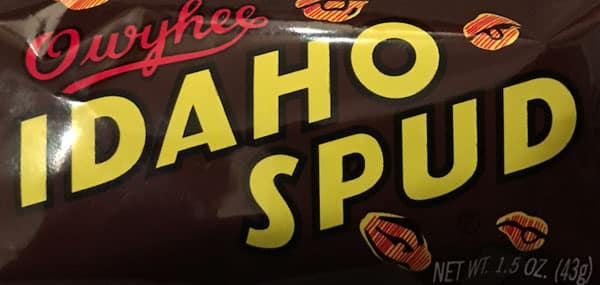
Ingredients & Nutritional Value
The original Idaho Spud was made of two marshmallow cores sandwiched by a chocolate covering to resemble a potato. Before chilling, the original Spuds were also hand-rolled in coconut. The technique of covering the Spuds with coconut was later mechanized when the Idaho Candy Company bought what was likely the only coconut depositor operating in the United States at the time, about 1970. In order to enhance output, one marshmallow center was switched at the same time that the depositor was introduced.
So what exactly does an Idaho Spud candy bar contain today? The Idaho Spud marshmallow breaks rather than stretches because, unlike bonfire marshmallows, the center is made of a lump of marshmallows rather than gelatin. The marshmallow core is then sprinkled with unsweetened coconut before being wrapped in chocolate.
The Idaho Spud candy bar consists of a marshmallow center with a cocoa flavor, covered in compound chocolate, and sprinkled with coconut flakes. The chocolate it contains is a substitute for real chocolate, produced from cocoa, sugar, and vegetable fats and dusted with coconut flakes. The candy bar’s oblong shape is similar to a potato. The piece of Idaho spud weighs 1.5 ounces, or 43 grams, and has 180 calories.
Ingredients of the candy include sugar, corn syrup, coconut, coconut milk powder, vanillin, artificial flavors, potassium sorbate, inverted sugar, corn starch, cocoa powder, chocolate liquor, egg albumen, agar agar, salt, soy lecithin, cornstarch.
People who have allergies to eggs, milk, and items with sulfites should stay away from this candy.
Nutrition
| Serving Size: | 1 bar (43g) | % Daily Value* |
| Amount Per Serving | ||
| Calories | 180 | |
| Calories from Fat | 70 | |
| Total Fat | 8g | 12% |
| Saturated Fat | 4g | 20% |
| Trans Fat | 0g | |
| Cholesterol | 0mg | 0% |
| Sodium | 8mg | 0% |
| Total Carbohydrates | 30g | 10% |
| Dietary Fiber | 1g | 4% |
| Sugars | 20g | |
| Protein | 0.5g | |
| Vitamin A | 0% | |
| Vitamin C | 0% | |
| Calcium | 0% | |
| Iron | 2% |
- Percent Daily Values are based on a 2000-calorie diet.
Pictures
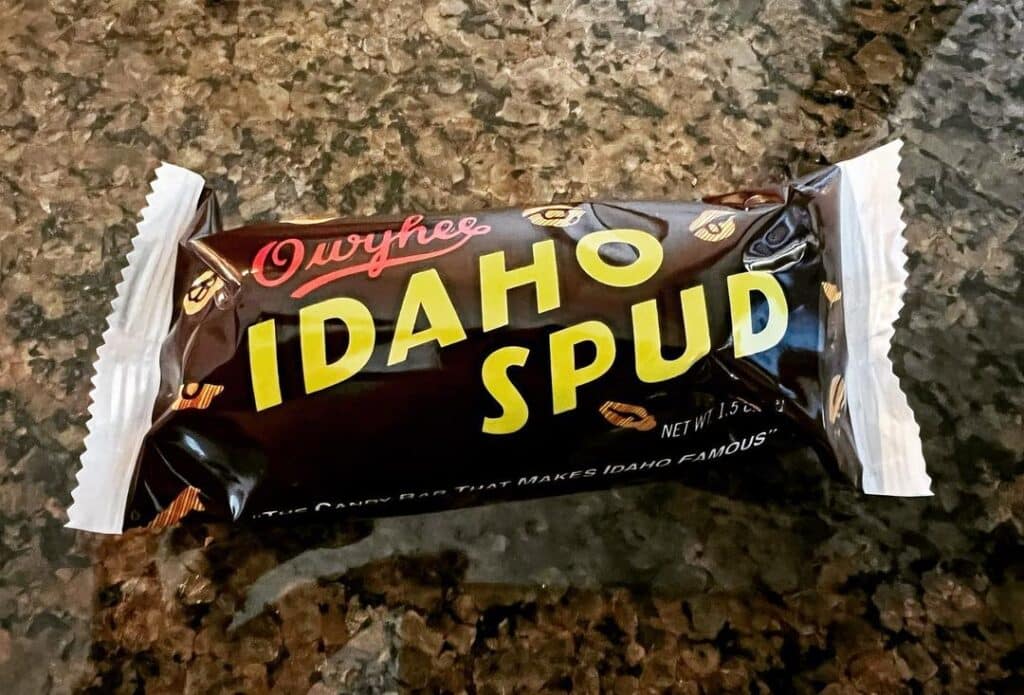
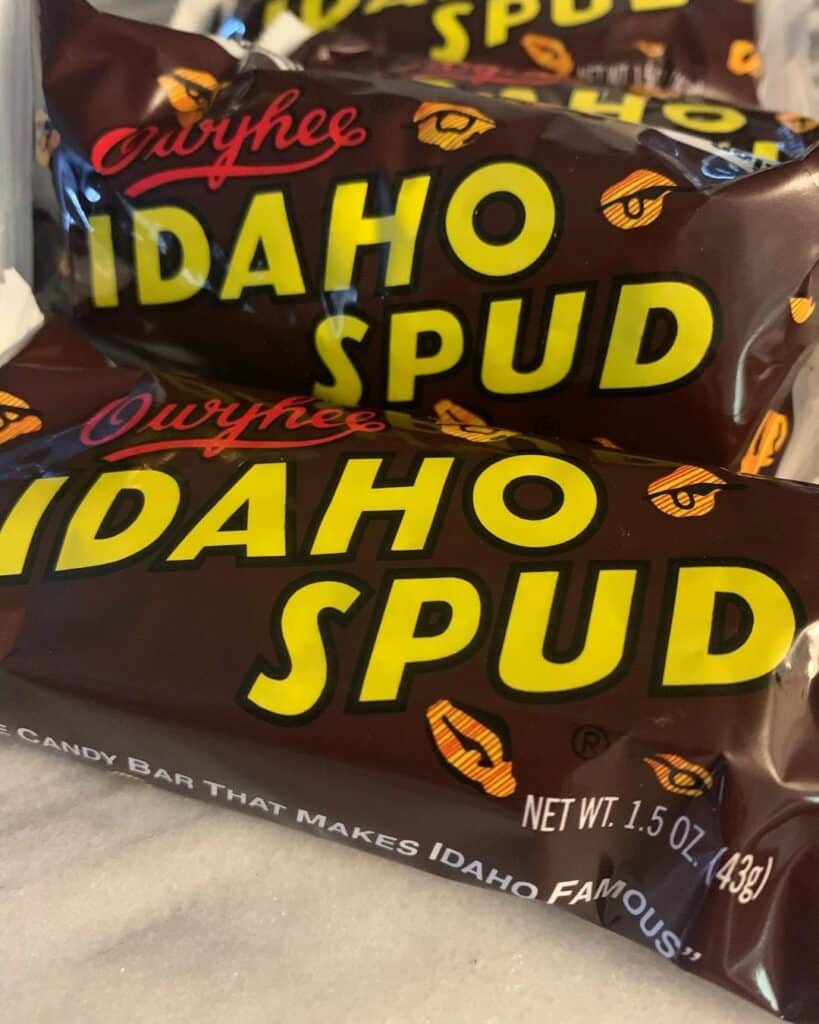
Bottom Line
Idaho Spud is one of the most popular candy bars produced by a tiny business. The candy bar has additionally appeared in the comedic series On Cinema on Adult Swim. The candy bar’s tagline, “The Candy Bar That Makes Idaho Famous,” is said to have contributed to Idaho Spud Candy Bar’s meteoric surge in popularity.

Nato is a content writer and researcher with a background in psychology. She’s passionate about writing about the candy industry and exploring the cultural significance of sweets and treats. She believes that the stories behind our favorite snacks can reveal a great deal about our values.
Please leave a review or any memories of this snack in the comments below. Thank you!
Click here for a full A-Z list of Snacks and Candy
